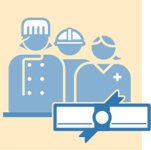Everyone in America — regardless of where they were born, the state where they live, the color of their skin, or the size of their bank account — should have the opportunity to achieve their goals. Ensuring broad opportunity and prosperity yields gains for everyone, but it won’t happen by chance. Smart state fiscal policies can play a critical role in building strong, equitable state economies.
A tax-cutting agenda shaped by — and primarily benefitting — the highest-income households and profitable corporations has long dominated in many states. These tax cuts have typically failed to produce economic benefits for the broad majority, and they have squandered resources that states could otherwise have invested in shared opportunity. Much of the economic gains of recent decades has accrued to a small number of wealthy Americans; people of color and women have plateaued at best. And some recent federal policy proposals would further weaken basic economic security for millions and shift even more income to the top.
One thing is clear: state fiscal policy has never mattered more. State policymakers can lay the foundation for opportunity to thrive in every corner of America by using available state fiscal policy tools to build state economies in which everyone can contribute and succeed. They can:
- Unleash residents’ potential and boost productivity by investing in education and health. States can target education dollars to early learning, smaller class sizes, and improved teacher quality to improve education outcomes, especially for students of color and low-income students. They can build a stronger workforce by expanding access to higher education and job training. They can also improve the economy by investing in public health, making workers more productive and raising the quality of life.
- Launch public infrastructure projects to create jobs, spur growth, and promote equity. Building and repairing roads, bridges, public transit, school buildings, and other physical assets creates jobs. When these projects are targeted to communities with the greatest need, they also can promote equity and broad prosperity, strengthening state economies for the long haul.
- Boost household incomes for shared prosperity. States can help families make ends meet and improve children’s life chances with state earned income tax credits and higher minimum wages. They also can remove barriers to work with child care and transportation assistance, and otherwise help families get on their feet. States also should look to remove other barriers to economic security and opportunity by reducing incarceration and taking an inclusive approach to undocumented immigrants, for example by offering driver’s licenses and in-state college tuition to students educated in the state’s K-12 system.
- Clean up and modernize the tax code and improve budget planning for a stronger future. Getting rid of ineffective, special interest tax breaks, incentives, and loopholes and asking the wealthiest to pay their share would free up new dollars for education, income supports, and infrastructure projects. Modernizing state sales taxes and leveling the playing field between online and brick-and-mortar businesses would raise billions of dollars for key priorities. Taxing carbon pollution and resource extraction would raise money for key public investments while also counteracting the effects of climate change on communities with limited financial resources.
State economies and communities thrive when public investment in the foundations of broad prosperity unlocks the potential of every person. Good schools in every community offer children from lower-income families a chance at a better future. Family economic supports help parents struggling on low wages to provide their children with stable housing, nutritious food, and less stressful home lives. Health coverage protects families from bankruptcy due to a health emergency or chronic illness and ensures that businesses have healthy, productive workers. High-quality infrastructure — roads, bridges, ports, and waterways — helps businesses get their goods to market, and building it creates good jobs in the short term when the economy is not at full employment.
These public investments also help generate the entrepreneurs of tomorrow and allow entrepreneurs to flourish. Most job creation is fueled by home-grown businesses, not the influx of out-of-state firms, and during periods of healthy economic growth, startups and young, fast-growing companies create most new jobs. [1] These firms want a high-quality workforce and public amenities (such as parks, libraries, and schools) that improve quality of life.[2] In addition, entrepreneurs are likelier to take necessary risks when they know there are economic supports to help them through tough times.[3]
Forward-looking public investments are key to creating these conditions. This report provides a blueprint of fiscal policies that can help create jobs now, remove barriers that limit opportunity for people of color, women, and others, and prime states for long-term prosperity.
This report provides a blueprint of fiscal policies that can help create jobs now, remove barriers to opportunity, and prime states for long-term prosperity.
 |
1. Unleash Residents’ Potential and Boost Productivity by Investing in Education and Health
- Unleash children’s potential with more early learning, smaller classes, and higher-quality teachers.
- Build a stronger workforce by expanding access to higher education and job training.
- Improve workers’ productivity and financial security with affordable health care.
|
 |
2. Launch Public Infrastructure Projects to Create Jobs, Spur Growth, and Promote Equity
- Repair and build schools.
- Build and restore roads, public transit, and water systems.
- Improve broadband access.
|
 |
3. Boost Household Incomes for Shared Prosperity
- Raise working families’ earnings.
- Buoy individuals and families facing major barriers to work.
- Reduce the number of adults and youth behind bars.
- Let immigrants contribute fully.
|
 |
4. Clean Up and Modernize the Tax Code for a Stronger Future
- Clean up special-interest tax breaks, incentives, and loopholes.
- Modernize state sales taxes and eliminate the unfair tax break for online retailers.
- Ask those benefitting the most from a state’s economy to pay their share.
- Tax carbon emissions and resource extraction.
- Protect investments in people and improve transparency with better planning.
|
1. Unleash Residents’ Potential and Boost Productivity by Investing in Education and Health
Failure to make the public investments that enable people to thrive, like education and health care, stifles human capital and diminishes productivity and quality of life. State policies can help unleash people’s potential to build a stronger economy and a higher standard of living for all of us. For example, states can target education dollars to improve education outcomes for students of color and low-income students. They can also improve the economy by investing in the public’s health, making workers more productive and raising the quality of life.
Unleash children’s potential with more early learning, smaller classes, and higher-quality teachers. States should invest in high-quality education systems, targeting these investments to promote greater racial equity and build a stronger future economy. Well-funded public schools help kids get a good start in life — especially when funding targets investments shown to produce better outcomes, such as early learning programs, smaller classes, and higher teacher quality. Such investments can benefit all children and close racial disparities.[4]
Public investments in early learning and K-12 schools are also highly complementary. For children living in poor families, the benefits of an early learning program increase when followed by greater funding for K-12 schools; likewise, spending on K-12 schools is more effective when preceded by investments in early learning.[5]
These types of investments also improve the economy and raise living standards. For example, high-quality preschool improves not only children’s academic performance but also, over time, the quality of a state’s workforce and jobs. Workers’ increased earnings alone outweigh the costs by more than five times, one study found.[6]
Build a stronger workforce by expanding access to higher education and job training. States with a better-educated workforce tend to have faster economic growth.[7] More public dollars for public colleges and universities and need-based financial aid would help states make higher education more accessible for aspiring students from families with low incomes. Similarly, customized job training that focuses on the basic skills sought by local employers has been shown to produce substantial payoffs.[8]
Improve workers’ productivity and financial security with affordable health care. Health coverage lets families and individuals get the preventive and ongoing health care they need, which keeps them healthier and more productive as workers. It also protects them from health-related financial shocks due to a health emergency or treatment for an expensive chronic illness.
The Affordable Care Act’s Medicaid expansion has enabled a majority of states to expand coverage to low-income adults; it has been particularly beneficial to states in dealing with the opioid crisis, providing coverage to many previously uninsured adults suffering from drug addiction.[9] It also has produced budget savings in a number of states.[10] Moreover, the availability of publicly funded coverage could help give potential entrepreneurs the confidence to take the risk of starting a new business, as one study has shown.[11] States should take advantage of opportunities to expand Medicaid to cover more people and provide greater economic security. States can also layer on their own state health insurance programs for people ineligible for Medicaid due to their income or immigration status.
The condition of roads, bridges, public transit, school buildings, and other physical assets greatly affects the economy’s ability to function and grow. These public investments can also promote equity and broad prosperity, strengthening state economies for the long haul. In fact, unleashing the potential of each individual and strengthening state economies require advancing equity across lines of gender, race, and economic status. State spending on schools and roads, for example, should prioritize the places that have been most neglected — typically those where families with low incomes and those that are predominantly of color live.
Repair and build schools. Each year, the United States spends $46 billion less than it should to build and repair K-12 schools to provide healthy and safe modern facilities.[12] This neglect hurts students’ health and school performance — and, by extension, weakens the country’s long-term prosperity.
While this underinvestment has occurred nationwide, the disparity between low- and higher-income communities is pronounced. The wealthiest school districts spent almost three times as much per student as the poorest districts to improve school facilities between 1995 and 2004, a study of almost 150,000 school improvement projects found.[13] As a result, a higher percentage of public schools in poor areas need repair than those in wealthier places.[14]
Because children of color are likelier to be in economically struggling communities, they’re also likelier to be in schools in need of repair. Further, when states allow their school buildings to fall into disrepair and fail to keep up with the need for new school construction, they add to the damage from other state funding cuts to schools. Reversing this decline is key to promoting full economic recovery and creating good jobs, which can be targeted to members of the very communities that have historically been most neglected.
Build and restore roads, public transit, and water systems. In its most recent report card on the condition of America’s infrastructure, the American Society of Civil Engineers gave U.S. infrastructure a D+ or “poor” rating. The engineers estimated the cost of bringing America’s infrastructure to a state of good repair (a grade of B) by 2025 at $4.6 trillion, of which only about 55 percent has been committed.[15]
Businesses small and large require well-maintained roads, railroads, airports, and ports so that manufacturers can obtain raw materials and parts and deliver finished products to retailers for sale to consumers. Healthy communities require well-functioning water and sewer systems. Reversing the serious decline in state investment in roads and transit, water treatment, and other forms of vital infrastructure will create jobs now and improve economic growth and job quality in the long run.[16] This is an especially good time to take on such projects, given today’s low interest rates.
Infrastructure spending also can improve racial equity. Often the communities most in need of upgraded schools and water systems, for example, are predominantly lower income and of color. Such projects could target communities suffering from neglect and, by hiring locally, provide needed job opportunities for community residents.
Improve broadband access. High-speed Internet connections have become central to participation in society. People use the Internet for job searches and interviews, education, health care, government services, and civic participation — and employers, educators, health care providers, banks, and retailers widely expect them to do so, which has helped turn broadband from a luxury into a necessity. People with low incomes who lack Internet access may face barriers to jobs and opportunities, especially since they often face other barriers like lack of transportation, inflexible job schedules, or limited or unreliable child care. States can improve access to high-speed Internet by supporting local efforts to expand broadband, providing grants for broadband in underserved areas, and connecting K-12 schools to federal funding for high-speed broadband and offering matching funds.[17]
Unevenly shared prosperity, where economic gains are concentrated among the richest households, limits opportunity for the broad majority.[18] Millions of families struggle to make ends meet because their jobs pay too little or offer inadequate, unpredictable, and inflexible schedules. Many others struggle because of employment barriers that are difficult or impossible to overcome, like a disability or criminal record. Women and people of color are especially likely to be paid low wages or face major barriers to employment.
Extreme income inequality and lack of economic mobility hold back state economies both in the short term, by weakening the purchasing power of poor and middle-class families (who spend all or most of what they earn), and in the long term, by making economic growth less sustainable.[19] Limited opportunity harms children in particular. Children in poor families not only perform less well in school than their better-off counterparts, but also earn less as adults.[20] Forgone earnings and other negative effects of child poverty create a substantial drag on the economy over the long run.[21]
State policymakers should redouble efforts to invest in economic opportunity, ease hardships for struggling families, reduce barriers faced by people of color and other marginalized groups, and put children on a better path in life.
Raise working families’ earnings. Working-family tax credits and minimum wage increases help ensure that workers can make ends meet. Twenty-nine states and the District of Columbia have enacted state-level Earned Income Tax Credits (EITC) to help working families earning low wages meet basic needs. State EITCs build on the success of the federal EITC by keeping working parents on the job and families and children on their feet. They also build on the federal EITC’s well-documented, long-term positive effects on children, boosting the nation’s future economic prospects.
States can also promote family economic stability by raising their minimum wage. Higher minimum wages help the lowest-wage workers and their families afford basics like decent housing in safe neighborhoods, nutritious food, reliable transportation, and quality child care, as well as educational opportunities that can move working families toward the middle class. The federal minimum wage hasn’t kept pace with the cost of living and is now 24 percent below its peak value in 1968, after adjusting for inflation; 29 states plus the District of Columbia have minimum wages that exceed the federal wage — several of them substantially so.[22]
Increases in state EITCs and minimum wages work best together; it’s not an either-or choice.[23] Both help to ensure that workers in low-paying jobs — including women and people of color, who are likelier to work in such jobs — share in a state’s economic gains.[24]
Buoy individuals and families facing major barriers to work. Building thriving communities also means supporting families and individuals who face the biggest barriers to work. These members of our communities may turn to public assistance when they aren’t paid enough to get by, are unemployed, need to care for a sick child, or face a crisis such as fleeing an abusive relationship. Many also face serious mental or physical health problems or chronic illness. States should maintain cash assistance and other supports like child care and transportation subsidies, funded by federal and state dollars, to help these families meet basic needs and find and keep jobs.[25]
Reduce the number of adults and youth behind bars. States can also expand opportunity by reforming their adult criminal justice systems and dramatically reducing the use of incarceration for youth and young adults. High rates of adult incarceration are costly to families, communities, and state budgets, particularly communities of color deeply weakened by overly harsh incarceration policies.[26]
Smart criminal justice reforms can enable marginalized members of society to participate more fully in the economy and produce significant savings that states can reinvest in affected communities. Some states, for example, have chosen to reduce the length of prison terms and parole/probation periods or to expand the use of alternatives to prison, such as addiction treatment programs for people convicted of drug-related crimes.
For youth, rates of arrest and incarceration have fallen dramatically over the past 10 to 15 years, presenting an opportunity to close prison-like youth detention centers and invest the savings into community-based approaches that nurture children and young adults and build stronger communities and local economies. These reforms have saved states millions of dollars and improved outcomes for young people, even as crime rates have continued falling.[27]
While such reforms are encouraging, states must do more to address racial disparities throughout the criminal justice system to ensure that all communities share in the gains. For example, African Americans and Latinos are likelier to be arrested and convicted of drug-related charges and receive harsher sentences than their white counterparts, despite similar rates of use.[28]
Let immigrants contribute fully. States can avoid the unnecessary social, economic, and financial costs of detaining unauthorized immigrants by leaving immigration enforcement to federal agencies. Instead, state policymakers can adopt more inclusive approaches that bring unauthorized immigrants into the mainstream economy, build a more educated and productive workforce, and allow immigrants to contribute to their fullest.
For example, states can strengthen enforcement of labor laws to ensure that all workers, including unauthorized immigrants, receive the wages they are legally owed. States also can allow in-state tuition and financial aid for immigrants that have long resided in the state, and provide access to driver’s licenses that enable them to get to work and become insured.[29]
4. Clean Up and Modernize the Tax Code for a Stronger Future
The public investments that underpin economic growth and help to build thriving, equitable communities — schools, health care, roads, and services for struggling families — offer big payoffs but require ongoing public support. Cleaning up the tax code by getting rid of tax breaks and loopholes that serve powerful interests can help states raise revenue to invest in people and communities. This means scrutinizing policies that let the wealthy and corporations avoid paying their share and shift the responsibility of paying for services that benefit everyone onto middle- and lower-income taxpayers.
In addition, long-term protection of public investments in quality schools, affordable higher education, accessible health care, and well-maintained roads requires thoughtful and transparent planning. The more accurate and useful information states have, the better decisions they can make about allocating resources. Policymakers can better plan for the future by laying out a clear budget roadmap, ensuring that analyses of the impact of tax and spending decisions are professional and credible, and instituting mechanisms that trigger needed mid-year changes when needed to keep the state on course.
Clean up special-interest tax breaks, incentives, and loopholes. States should regularly monitor and evaluate economic development subsidies and eliminate those that are ineffective. These incentives for businesses cost state and local governments $45 billion each year, despite the fact that, on a whole, they’ve not been effective at reducing unemployment, raising incomes, or growing state economies.[30]
More broadly, states should scrutinize the billions of dollars they spend each year through the tax code in the form of credits, deductions, and exemptions. For the most part, policymakers don’t regularly examine these “tax expenditures” for effectiveness the way they examine yearly budget appropriations. For example, a state agency has to make its case to the governor and legislature each year for the level of funding necessary to serve state residents, but a tax break for a certain type of business could continue (and even grow in cost) without scrutiny or debate.
States also can nullify a variety of tax-avoidance strategies employed by large multistate corporations by adopting a reform known as “combined reporting,” which treats a parent company and its subsidiaries as one entity for state income tax purposes.[31] And, by adopting a reasonable minimum corporate tax, states can ensure that every corporation operating in the state pays at least a reasonable minimum tax to support the public investments that undergird a thriving private economy.
Modernize state sales taxes and eliminate the unfair tax break for online retailers. Antiquated tax systems ill-suited to the 21st century economy hamper states’ ability to restore school funding, rebuild budget reserves, and invest in the future. For instance, many states primarily levy sales taxes on tangible goods, even though services — many of which didn’t exist when sales taxes were first enacted, such as video streaming — make up a growing share of consumption. States can halt the erosion of their sales taxes and improve their long-term ability to invest in state priorities by broadening the sales tax to include more services.[32]
States should also act to ensure that businesses collect sales taxes on online purchases; the failure of Internet sellers to collect and remit state and local sales taxes costs states billions of dollars each year.[33] Similarly, many states don’t require online travel companies like Expedia, Orbitz, and Priceline to collect and remit the appropriate tax on hotel room bookings.[34]
Ask those benefitting the most from a state’s economy to pay their share. Individuals and families with the highest incomes and the greatest wealth pay the least in state and local taxes, when measured as a share of income. Policymakers could reduce today’s extremely high levels of income and wealth inequality by boosting income tax rates for the highest-income households and scaling back tax breaks that disproportionately benefit them.[35] And they could tax large inheritances by reinstating or expanding state estate or inheritance taxes.[36]
Tax carbon emissions and resource extraction. Carbon pollution is increasing global temperatures, with harmful consequences including more droughts, rising sea levels, and more severe weather, weakening the economy’s health and potential. A carbon tax or other method of “putting a price on carbon” can generate substantial revenue for critical investments while also reducing carbon pollution.
Low-income communities often bear the brunt of the negative environmental effects of carbon pollution. Yet low-income households would be hit hardest by taxes on carbon pollution because they spend a bigger share of their income on energy and energy-related products than do higher-income households.[37] States can design carbon-tax measures to generate enough revenue to fully offset the hit to the lowest-income households from higher energy prices, cushion the impact on many other households, and leave plenty to spare for other uses. In addition, states that levy severance taxes on resource extraction can close loopholes in these taxes to fund core priorities like education, health, and infrastructure.
Protect investments in people and improve transparency with better planning. States routinely put at risk some of their highest priorities ― educating children, maintaining a healthy and trained workforce, and caring for the elderly, for example ― by failing to employ proven tools for planning further into the future. For example, only a handful of states regularly prepare “current services” budgets (which estimate the cost of maintaining the current level of services) extending beyond one budget year. By better estimating both their likely revenues and the cost of continuing core services, states can help ensure that they have the resources to invest in the building blocks of strong economic growth and widespread prosperity.[38]
Policymakers can make better and more transparent spending and tax decisions if they have accurate information about the costs. Nearly all states produce some sort of cost estimate, typically called a “fiscal note,” but they often fail to look beyond a one- or two-year window, are not revised when the legislation is amended, or are only produced for a narrow set of bills.[39] This lack of information can lead to policy changes that cause serious fiscal problems and makes it hard for the public to hold lawmakers accountable.
Additionally, states should strengthen their “rainy day” reserve funds, which help offset revenue declines during economic downturns and are crucial to prudent fiscal management.[40] In hard times, these funds can help protect state investments that promote economic growth and sustain demand for private-sector goods and labor. States without such funds should create them; states with arbitrary or onerous restrictions on their use should reform them.
